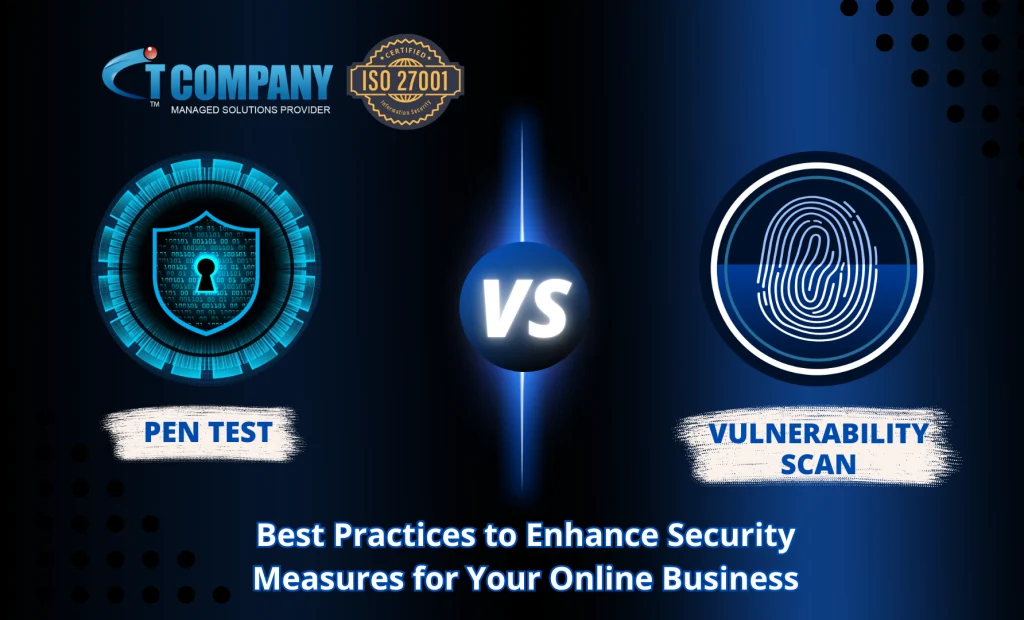
Table of Contents
ToggleIn today’s digital landscape, online businesses must prioritize security to protect assets, data, and customers. Two vital components are pen test vs vulnerability scan. Pen tests simulate real-world attacks to identify weaknesses, while vulnerability scans detect potential flaws systematically. Both are crucial for a robust cybersecurity strategy. This guide will clarify their differences and provide best practices to enhance your online security and safeguard your operations effectively.
What is a Pen Test?
A penetration test, or pen test, simulates a cyberattack on your system to identify vulnerabilities that could be exploited by attackers. It is a thorough and in-depth assessment typically conducted by skilled security professionals who mimic the tactics of real-world hackers.
What is a Vulnerability Scan?
A vulnerability scan, on the other hand, is an automated tool that reviews your systems and networks to identify known vulnerabilities. It provides a broad overview of potential weaknesses without simulating an attack, making it less invasive and quicker than a pen test.
Difference Between Pen Test and Vulnerability Scan
| Feature | Penetration Test (Pen Test) | Vulnerability Scan |
| Purpose | Simulates a real-world attack to identify exploitable vulnerabilities. | Identifies known vulnerabilities in systems and networks. |
| Method | Conducted manually by skilled security professionals. | Automated scanning using specialized tools. |
| Depth of Assessment | In-depth analysis of vulnerabilities and potential exploit pathways. | n-depth analysis of vulnerabilities and potential exploit pathways. |
| Frequency of Use | Typically conducted on a periodic basis or after significant changes. | Regularly scheduled to ensure ongoing compliance and security posture. |
| Invasiveness | More invasive, as it mimics actual attacks. | Less invasive, as it only scans systems without attempting exploitation. |
| Reporting | Detailed reports often with remediation advice and verified findings. | General reports listing vulnerabilities without in-depth analysis. |
Why Do You Need Them?
Pen Tests
- Real-world Attack Simulation: Pen tests mimic actual hacking attempts, providing insights into how your defenses hold up against real threats.
- Detailed Analysis: They offer an in-depth view of your security posture, identifying vulnerabilities that automated tools might miss.
- Compliance Requirements: Many industries mandate pen tests to comply with regulations and standards, such as PCI DSS for payment processors.
Vulnerability Scans
- Routine Check-Ups: Regular scans help maintain security hygiene by identifying potential weaknesses before they become serious threats.
- Cost-Effective: Automated scans are generally more affordable than full pen tests, making them an attractive option for smaller businesses.
- Quick Overview: They provide a snapshot of your current security status in a relatively short time.
Why Consult for Services?
In engaging with professional security services for pen test vs vulnerability scan, you gain valuable insights into system weaknesses. Pen test vs vulnerability scan provides in-depth analysis and actionable results. These benefits mention below:
Expertise: Professionals bring in-depth knowledge and experience, ensuring thorough assessments.
Objective Insight: External experts provide unbiased evaluations, free from internal biases or oversights.
Advanced Tools: Security firms often have access to sophisticated tools and methodologies not available in-house.
Benefits of Implementing These Practices
- Improved Security Posture: Regular testing and scanning help identify and mitigate risks, strengthening your overall security framework.
- Risk Management: By understanding your vulnerabilities, you can address them proactively, reducing the likelihood of a successful attack.
- Customer Trust: Demonstrating a commitment to security can enhance your reputation, building trust with customers who value data protection.
Best Practices for Enhancing Security Measures
- Regularly Schedule Tests and Scans: Make pen tests and vulnerability scans a routine part of your security protocol.
- Combine Both Methods: Use vulnerability scans for ongoing maintenance and pen tests for deep dives into high-risk areas.
- Consult Professionals: Work with experienced cybersecurity firms to ensure comprehensive evaluations.
- Act on Findings: Develop a plan to address vulnerabilities identified during tests and scans, prioritizing critical issues.
- Stay Updated: Keep abreast of new threats and update your testing methodologies accordingly.
Conclusion
In conclusion, both pen tests and vulnerability scans are essential components of a robust cybersecurity strategy. By understanding their unique roles and benefits, you can better protect your online business from potential threats. To take your security measures to the next level, consider consulting with professionals who can tailor these services to meet your specific needs.

What is the difference between penetration testing and vulnerability scanning?
Vulnerability Scanning: An automated process that uses tools to scan systems for known vulnerabilities. It typically generates a report of potential weaknesses but doesn’t usually include exploitation or deeper testing.
How often should I perform penetration testing and vulnerability scans?
Vulnerability Scanning: Should be performed regularly, such as monthly or quarterly, and ideally after significant changes to the network or systems to identify new vulnerabilities.